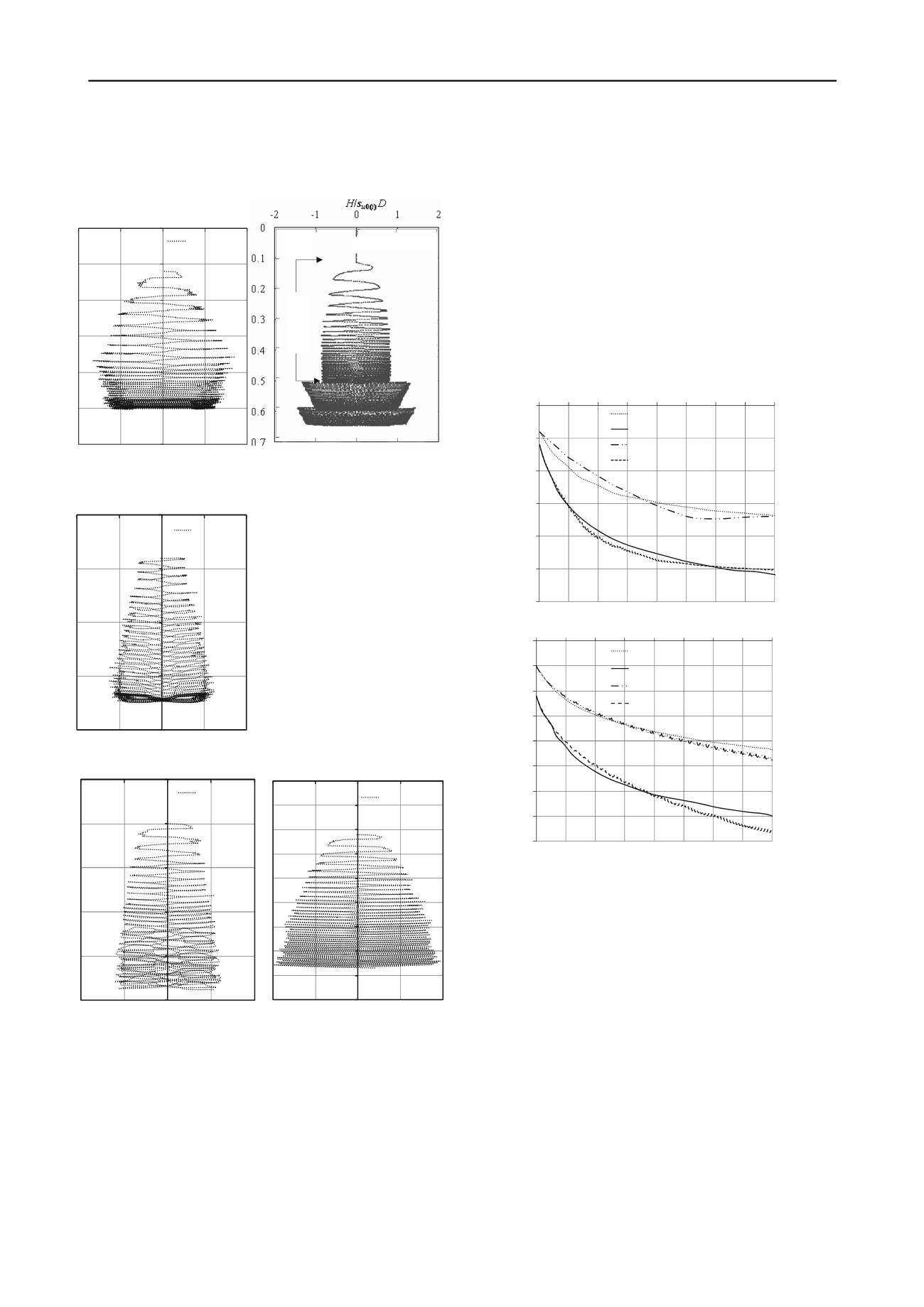
2349
Technical Committee 209 /
Comité technique 209
significantly after 20-30 load cycles for kaolin clay. However,
the pattern is somehow different for high plastic clay as shown
in Fig. 5(b) where the pipes continue to penetrate even after 20-
30 load cycles.
0
0.1
0.2
0.3
0.4
0.5
0.6
-2
-1
0
1
2
H
/
s
u
0(
i
)
D
KC-05 (CEL)
0
0.1
0.2
0.3
0.4
-2
-1
0
1
2
w
/
D
H
/
s
u
0(
i
)
D
KC-04 (CEL)
0
0.1
0.2
0.3
0.4
0.5
-2
-1
0
1
2
w
/
D
H
/
s
u
0(
i
)
D
HP-06 (CEL)
Figure 3.Test KC-05 (a) present study (b) centrifuge test.
From field experience in
deepwater pipeline projects in
West Africa, Casola et al.
(2011) suggested that the
embedment of pipelines is more
than
D
/3 and the lateral cyclic
load has little effect on pipe
embedment. Their observed
behaviour might be applicable if
s
u
0
and the gradient (
k
) of
s
u
0
is
high as they found in these
projects. However, for the cases
analyzed in the present study,
the cyclic loading has a
significant effect even after
embedment of
D
/3 as shown in
Fig. 5(b).
Figure 4. FE results (a) KC-04 (b) HP-06 and (d) HP-07.
5 DYNAMIC EMBEDMENT
In the current engineering practice the effects of laying and
dynamic embedment are assessed separately. The lay effect on
vertical load (
p
) is obtained by multiplying the submerged unit
weight of the pipe by an empirical lay factor (
f
lay
). The
monotonic embedment (
w
mon
) for this load
p
is calculated using
the bearing capacity theory. The effect of small amplitude cyclic
lateral motion is incorporated using another empirical factor
known as dynamic embedment factor (
f
dyn
). Finally, the total
embedment (
w
f
) is calculated as
w
f
=
f
dyn
w
mon
. In some projects
(e.g. Oliphant and Yun 2011) a combined empirical factor
(=
f
lay
f
dyn
) is also used that accounts for both laying and
dynamic effects. Table 3 shows the calculated values of
f
dyn
for
the four tests simulated in this study. Analyzing field data of a
200 km offshore pipeline in shallow to deep water, Oliphant and
Yun (2011) showed that an average value of
f
dyn
of
approximately 7 could be used for estimation of pipeline
embedment. Lund (2000) suggested that the value of
f
dyn
in the
field varies between 2 and 10.
q
for two
with horizontal cyclic motions (a) Kaolin
(b) High plasticity clay.
(a)
(b)
KC-05(Centrifuge)
Stage-I
6 EQUIVALENT PLASTIC STRAIN AND BERM SHAPE.
During penetration the soil around the pipeline is softened as a
function of plastic shear strain as shown in Eq. 1. The
w
/
D
e uivalent plastic shear strain at the end of penetration
0
0.1
0.2
0.3
0.4
0.5
0 5 10 15 20 25 30 35 40
w
/
D
No of Cycles
Figure 5.Pipeline embedment
clay
cases (KC-04 and KC-05) are shown in Figs. 6(a) & 6(b). A
significant plastic strain (>500%) is developed near the pipe.
The white broken lines in Figs. 6(a) & 6(b) show the boundary
above which the equivalent plastic shear strain is greater than
95
(=10). That means 95% degradation of undrained shear
strength occurred in the soil above this line (see Eq. 1). In other
words, the undrained shear strength of the soil in the zone above
this line is almost near the remoulded undrained shear strength.
In order to show the effects of lateral cyclic loading on
penetration, an analysis is performed for monotonic penetration
as shown in Fig. 6(c). The geometry and soil property used in
this analysis is same as KC-05 in Fig. 6(b), except the pipe
moved monotonically downward to the depth of final
embedment in KC-05 using a displacement boundary condition.
The shear strain and berm formation for monotonic penetration
is shown in Fig. 6(c). the equivalent plastic shear strain near the
pipe in monotonic loading is significantly lower (Fig. 6c) than
that obtain in lateral cyclic loading (Figs. 6a&b). The maximum
plastic shear strain developed near the pipe in cyclic loading is
almost 5 times higher than that of monotonic loading. Also the
maximum equivalent plastic shear strain is less than
95
, which
means that the shear strenth reduction due to softening is less
0
0.1
0.2
0.3
0.4
0.5
0.6
0.7
0.8
0.9
-2
-1
0
1
2
H
/
s
u
0(
i
)
D
HP-07 (CEL)
(c)
(b)
0.6
KC-04(Cheuk and White 2008)
(a)
KC-05 (Cheuk and White 2008)
KC-04 (Present study)
KC-05 (Present study)
(a)
0
0.1
0.2
0.3
0.4
0.5
0.6
0.7
0 5 10 15 20 25 30 35 40
w
/
D
No of Cycles
0.8
HP-06 (Cheuk and White 2008)
(b)
HP-07 (Cheuk and White 2008)
HP-06 (Present study)
HP-07 (Present study)


